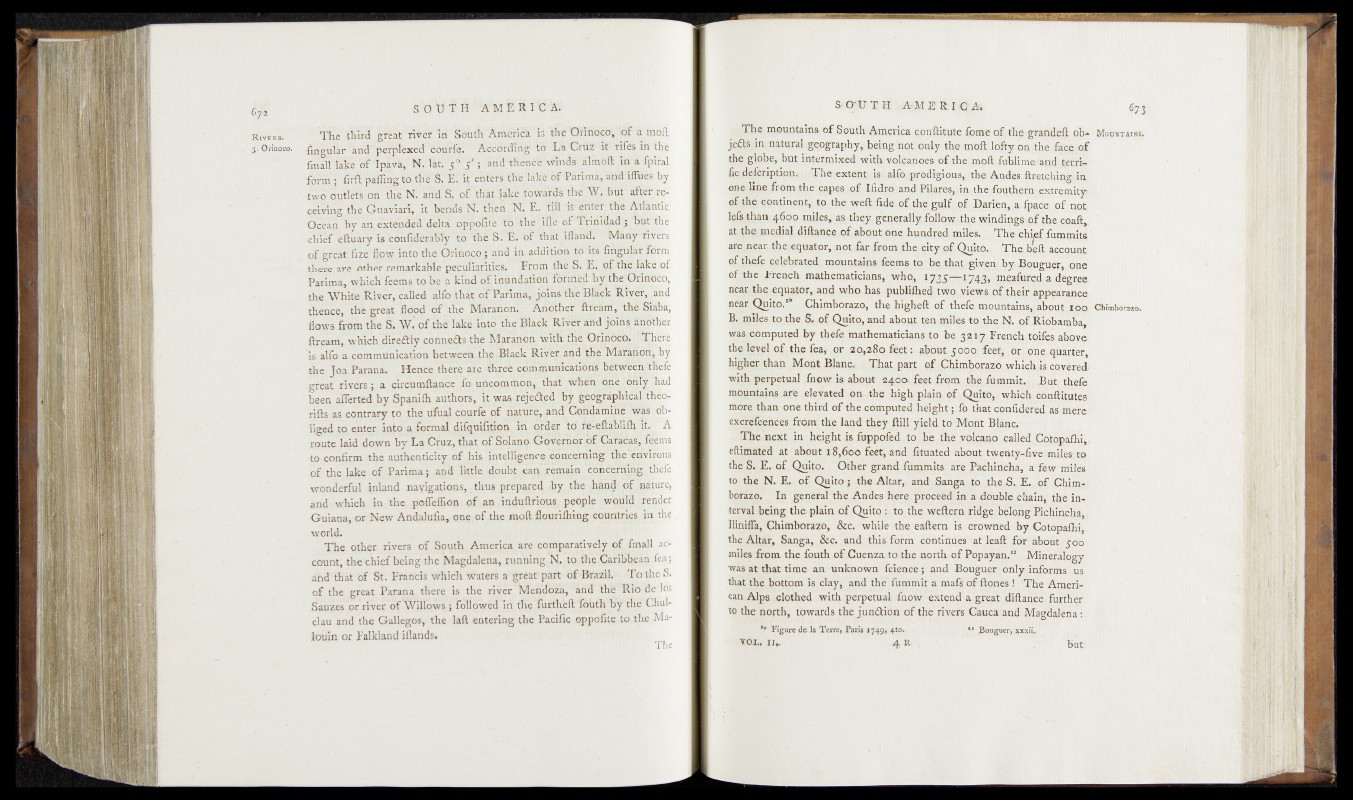
P s o t f a AM E R I'C Av
RrWks.
.3. Orinoco.
The third great river in South Aiùérlcâ iâ ïhe 'Orinoco, of a moft
•Angular and perplexed courla. According to La Cruz it rifes in the
fmall lake 'of Ipava, N. lat. 5 0 5' ; arid thence winds almoft in a fpiral
f orm ; firft paffing to the S. E. it entere the lake of Parima, and ifluesjfey
-two outlets on tlie N. and S. of that fake towards the W. but after,receiving
the Guaviari, it bends N. then N. E. till it enter the Atlantic
Ocean by an extended delta oppolite to the ifle. of Trinidad ; btit t*he
chief eftuary is cohfiderahly to ‘fhe^TÉVof’ that lflkndJ'- Mahyriyers
o f great fize flow into the Orinoco^and in. addition’^ Whrigu.|âf form
there are other remarkable peculiarities. From ffee S. -Ê. of fh'é lake of
Parima, which feems to be a kind of inundatidn torined hy the'Onnoho,
the White River, called alfo ,'that rif Farima, ibiris the *Btaek River, arid
thence, thé great flood of the Maranon. Another ftreàm, thedSaba,
flows from the S. Wl of the lake into the'Black River and joins l&dther
ftreàm, which direûly côimeâs the Maranon with .the 'Otjinbçô,’ {There
is alfo a communication between the Èlack River and tlje mârânohjihy
the Joa Parana. Hence there are three communications betwee|Shefe
great rivers ; a circumftance fo uncommon, that ifahen-pne 'only had
been afferted by Spanifli authors, it was ’rejected by gedgraphica&ieo-
rifts as contrary to the ufual çourfe of n-arare,.and Coridamin'e was ^obliged
to enter into a formal difquilition, in order to' re-eftahhm it. IA
route laid down by La Cruz, that qf Solano Governor of Caracas^ feems
to confirm the authenticity of his intelligence concerning the environs
of the lake of Parima ; and little doubt cap, remain cohc'ermnKfliefe
wonderful inland nayigations, thus prepared by the hand ^ j ^ p r e ,
nnd which in the ;RoflTeflBorn, of ,an in^ftriqu^ people would ^Q^er
Guiana, or New Andalufia, one, of the ,n*oft flo.urifliin^ eoprft|^ö%pf
world.
The oth,er livers of South America afe comparatively of fnjall fee-
count, the chief being the Magdalena, running N /to the Caribbean fca ;
and that of St. Francis which waters a great part o f Brazil. To the S.
of the great Parana there is the river. Mendoza? arid thé Rio
gauzes 'pr,river ofWÎlîo^s ; followed 'in the fûfthèft'fèbthTy fHë'CHul-
clau and the Gallegos, the laft entering the Pacific oppoflte to the Ma-
louin or Falkland iflands.
;, ■'&OT7 1 It -AiMER 1 CfA. 673
The mountains ofSout-h America .porf^itute feme p f the grandeft ob* Moo-staim.
jeAs, in-natural geography, being -notgpidy lojlyon^he face of
the globe, fu^intermixed with volcanoes, of,the jhfiimecand, terri- '
fic defcriptlon. ®ie extend i^alfo^prod^ou^ -tb© And^^étyjiingiiti
one line from the capes Af.Ljdpoi'anjd Filafesyfr^he fefthern pxtre.toityjfi
of the ^enqnent^ t^o the wejft ftde(,phthe>gplf;,pf'(! E^arien, a fpace of not
l?l§J%fea.0 40°° ipiles, as they generally,fbjlqw^tbe yyipdipgs-p^tjhe coaft,
at the, 'niqdial diftanpe of about o,0e hundred, miles., The chief fummits
aref}jear thejequator, not far- from the,citysof Quito. The beft account
of tjiefe celebrated, mountains feems to be that, gjy^nrby. JBouguer, one
of the Trench mathematicians, who, i7dT~l;74JY {neafured a degree
near the equator, and who has publifhed two views pf, their appearance
near Quito. Chimborazo, the higheft o f 't i y e f è lm o V n t a in ^ a h p u t ’. ip ^ Chimborazo.
B. iniles to the S. .of Quito, and about ten.mjle&to, the N. of Riobarpba,
was computed by thefe mathematicians,to be 3217 French .tdfes, abov«-
the level of the fea, or 20,280 feet: abput^op’q -feet, .orionq, Quarter,
higher than Mont Blanc, That part of Chimborazo \yhifkis cqyered
with, pe^jetual fnow is about 2400. feet from tie fufnmit-i^Bnt thefe
mpflntains^ajre eleyated on; the high plain ©f Quito,, whicht conffetutes
more than one third of the computed height ;5ft> that cpnfidered'as^inere -
excréféénces from the land they Hill yield to Mont Blanc.-
The next in height is-fuppofed tp>'5be,the vqigano c^ll^d-Cotopafhi,,
eftituatèd at about t§,600 feet, and fituated about, twenty-fiye mileito
the S. E. of Quito. Other grand fummits are Pachincha, a/féïy mill's
tp the N. E. of Quito; the Altar, and Sanga to, ,the^S. E^oJhEhjm^
borazo. In general the Andes hpre procecTin a double chain,-thé interval
being the plain of Quito: to the weftern ridge belong PicHincha,.
Ilinifia, Chimborazo, &c. while the eaftern is crowned by Cotopaflis,.
the Altar, Sanga, &c, and this,form continues atjéafl: for aboiit job-
iniles from the fouth of Cuenza to the north of Popayan.” Mineya^rar
was at that time an unknown feience} and. Bouguer only informs us
that the bottom is clay,- and the fummit a mafs of ftori'es ! Tfle Ameri-
ean Alps clothed with perpetual dhow -.extend a great diftance further
to the nojrth, towards the junction of the rivers Cauca-and Magdaleha:.
10 Figure d^ la Terre, Paris 1749» 4to- • -Bouguer, .xxxii.
UOiL, 11^- 4; Rj but: